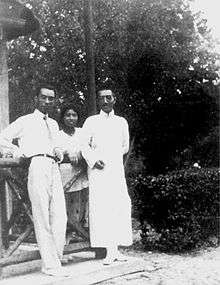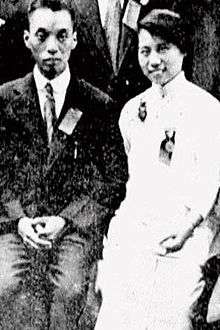Chen Hengzhe
.jpg)
Chen Hengzhe or Ch'en Heng-che (Chinese: 陈衡哲; 12 July 1890—1976) pen name Sophia H. Z. Chen 莎菲, was a pioneering writer in the new literature vernacular Chinese style and a leader in the New Culture Movement and the first woman to be a professor at a Chinese university.[1]
Life and education

Chen Hengzhe's family was from Hunan Province although she was born in Wujing, Jiangsu Province. Her parents encouraged her to follow the traditions of her extended scholarly family, but she could not find a school in which she could study formally. When she defied her father's choice for her husband, however, her paternal aunt took her in, tutored her, and found her a teaching position.[2]
In 1911 she went to study in Shanghai and learned English. Tsinghua University set up examinations in Shanghai to send students overseas for study on Boxer Indemnity Scholarship Program. She successfully passed the examinations in 1914, entering Vassar College to earn her BA in history and membership in Phi Beta Kappa. She then went to the University of Chicago for her master's degree in History.
On a visit to Cornell University in 1916, she met Hu Shih, who was studying philosophy, and her future husband Ren Hongjun (任鸿隽 H. C. Zen), who was studying chemistry. Returning to China in 1920, she taught Western history at Beijing University. Chen married Ren Hongjun on September 27, 1920. She and her husband had three children, a son and two daughters. The eldest daughter, E-tu Zen Sun, earned a PhD at Harvard University under John K. Fairbank and published widely.[3]
Role in the New Culture Movement and later career
The trip to Cornell in 1916 to meet her future husband and Hu Shih was a turning point for her. When the group of friends was drenched in a sudden downpour while rowing on Lake Cayuga, Ren composed a long poem in classical Chinese which Hu criticized for using "dead phrases of three thousand years ago" for such an everyday event. Sophia and Hu took part in a "great pen war" over the use of classical Chinese. Ch'en's short story "One Day," based on college life at Vassar, was published in Chinese Students' Quarterly, and is known as the first short story in the new literary vernacular language, baihua.[4]
Hu a leader in the heated debates about establishing the new Chinese literature, wrote in the forward to her 1928 "Raindrops" collection:
- In July and August of 1916, I had the most heated discussions about literature with Mei Renzhu [(梅光迪)Mei Guangdi]. She would not participate in this pen and ink warfare. But she sympathized with my ideas and gave me encouragement. She was my earliest comrade.
- When we were discussing the new literature, Sophia was already writing in vernacular Chinese。 “One Day” was the earliest work during those preliminary discussions about the literature revolution. "Raindrops" was also the earliest creative work during the "New Youth (Xin Qingnian)" period. After 1917, Sophia authored many vernacular poems. We should think about the conditions of that time regarding the new literature, think about when Lu Xun published his "A Madman's Diary", think about how few writers were using vernacular. We then can understand the proper place in the history of our new literature movement for these short stories by Sophia."[5]

Returning to China in 1920, she taught western history at Peking University. After she married Ren Hongjun in 1920, she worked for a time at Commercial Press. During this time, she published essays in key New Culture journals, and the first textbook of western history. In 1932, she was one of eight founders, along with Hu, of the magazine of literary and political commentary, Duli Pinglun (Independent Critic), which published articles of a western liberal orientation.[6]
When her husband was made president of Sichuan University in 1935, she taught there briefly. But her critical essays in Duli Pinglun on Sichuan made her unwelcome, and she returned to Peking, only to flee at the onset of the war in 1937 to Shanghai, then Hong Kong, Kunming, and eventually Chongqing, the wartime capital. She grew disillusioned with the Nationalist government, and she and her husband remained in Shanghai after the Communist victory in 1949. Her husband died in 1961, and she, after much abuse during the Cultural Revolution, died in Shanghai 1976.[7]
Representative Publications
- "One Day" 一日, 1917 translated in Dooling, A.D., and K.M. Torgeson, eds. Writing Women in Modern China: An Anthology of Literature by Chinese Women from the Early Twentieth Century. Columbia University Press, 1998. pp. 90-99
- "Raindrops" 小雨点 a short story, 1917, in "New Youth (Xin Qingnian)"
- "Question of Rogers" 洛绮丝的问题
- "Raindrops" 小雨点 a collection, 1928, Xinyue 新月 publisher
- --, ed. Symposium on Chinese Culture. Shanghai, China: China Institute of Pacific Relations, 1932.
- "The Chinese Woman and Other Essays." (Peiping, 1933 Google Book.
- "A History of Renaissance" 《文艺复兴史》
- "Western History" 《西洋史》, Commercial Press Publisher
- "Autobiography of a Chinese Woman" 《一个中国女人的自传》
- "Sophia's Essays" 《衡哲散文集》
References
- Schwarcz, Vera. The Chinese Enlightenment: Intellectuals and the Legacy of the May Fourth Movement of 1919. Berkeley: University of California Press, 1986.
- "Ch'en Heng-che," in Howard L. Boorman, ed., Biographical Dictionary of Republican China. (New York: Columbia University Press, 1967). Vol I, pp. 184-87.
- Feng, Liping (April 1996). "Democracy and Elitism: The May Fourth Ideal of Literature". Modern China (Sage Publications, Inc.) 22 (2): 170–196. ISSN 0097-7004. JSTOR 189342.
- H. D. Min-hsi Chan, Qi Wenying, “Chen Hengzhe,” in Lily Xiao Hong Lee, ed., Biographical Dictionary of Chinese Women. Vol II "The Republican Period,"(Armonk, N.Y.: M. E. Sharpe, University of Hong Kong Libraries Publications, 1998) pp. 58–61.
Further reading
- Chen Hengzhe 陈衡哲 (Chinese text) Chinese Wikipedia zh:陈衡哲
- Chen Hengzhe 陈衡哲 (Chinese text) Baidu baike
- Ren, Hongjun, Chen Hengzhe, 任鸿隽陈衡哲家书 Ren Hongjun Chen Hengzhe Jia Shu (The letters of Ren Hongjun and Chen Hengzhe). Beijing: Shang wu yin shu guan, 2007.
- Chen Hengzhe, Feng Jin, ed., Chen Hengzhe Zao Nian Zi Zhuan (My early years). Hefei: Anhui jiaoyu chubanshe 2006.
- "My Childhood Pursuit of Education: In Memory of My Uncle, Chuang Ssu-chien," in Ng, J., and J. Wickeri. May Fourth Women Writers: Memoirs. (Hong Kong: Chinese University of Hong Kong - Research Centre for Translation, 1996.
- "Influence of Foreign Cultures on the Chinese Woman," in The Chinese Woman and Four Other Essays (1934), reprinted in Li, Yuning, ed., Chinese Women Through Chinese Eyes (Armonk, NY: M.E. Sharpe, 1992), pp. 59–71.
Notes
| Wikimedia Commons has media related to Chen Hengzhe. |
- ↑ "Ch'en Heng-che," in Howard L. Boorman, ed., Biographical Dictionary of Republican China. (New York: Columbia University Press, 1967). Vol I, pp. 184-87.
- ↑ Sophia Z.H. Chen, "Influences of Foreign Cultures on the Chinese Woman," (1936) reprinted in Li Yu-ning, ed., Chinese Women through Chinese Eyes (Armonk,NY: ME Sharpe, 1992), p. 59
- ↑ H. D. Min-hsi Chan, Qi Wenying, “Chen Hengzhe,” in Lily Xiao Hong Lee, ed., Biographical Dictionary of Chinese Women. Vol II "The Republican Period,"(Armonk, N.Y.: M. E. Sharpe, University of Hong Kong Libraries Publications, 1998) p. 61.
- ↑ Stacey Bieler, Patriots Or Traitors: A History of American Educated Chinese Students (Armonk,NY: M.E. Sharpe, 2004) pp. 200-202
- ↑ quoted in 李瑾 Li Jin “我们三个朋友”:胡适、任鸿隽和陈衡哲 " (Women sange pengyou: Hu Shi, Ren Hongjun, Chen Hengzhe), Southern.com July 15, 2005.
- ↑ Bieler, Patriots Or Traitors pp. 200-202
- ↑ Bieler, Patriots Or Traitors pp. 200-202